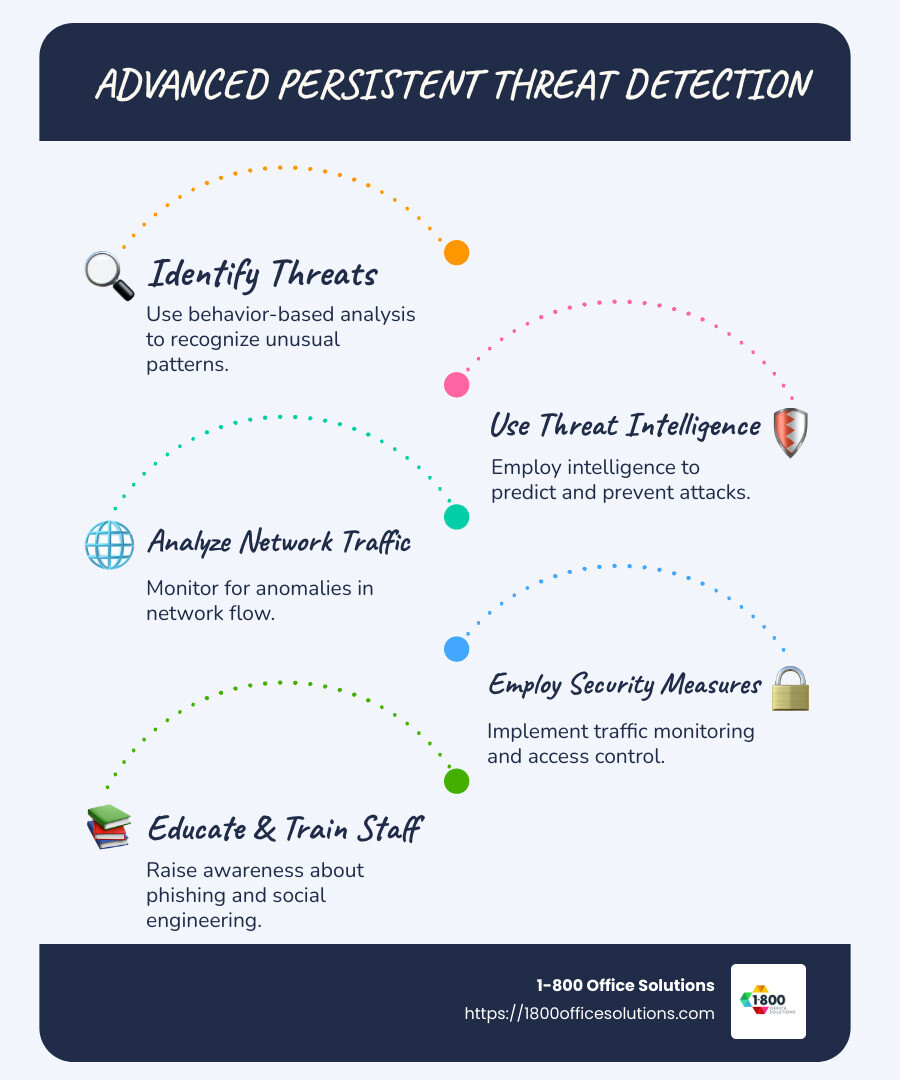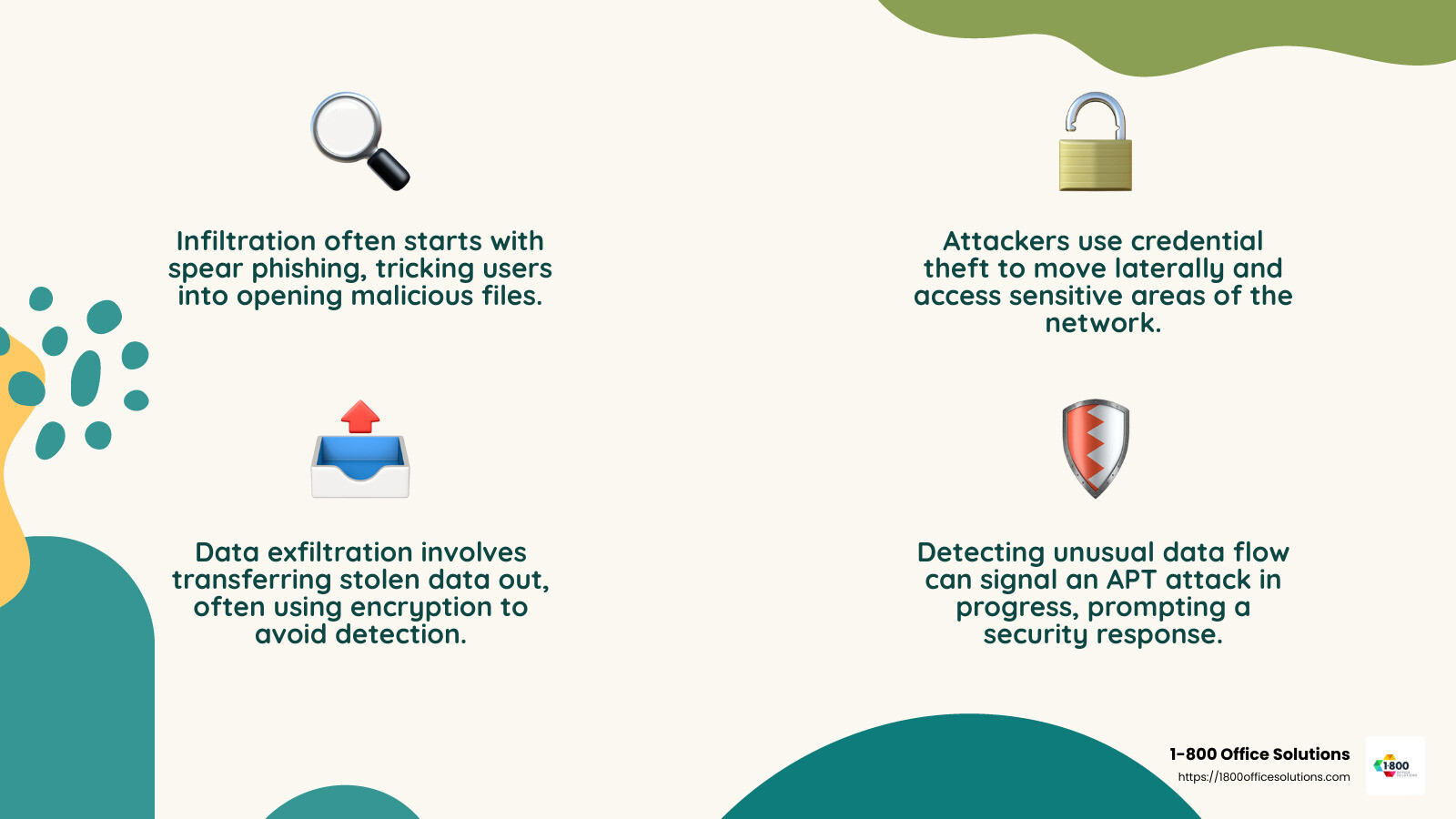The Art of Detection: Understanding Advanced Persistent Threats
Advanced persistent threat detection is crucial in defending against cyber attacks that could quietly compromise your network. Here’s a quick guide to understanding it:
- Advanced Persistent Threat (APT): APTs are long-term, targeted attacks that infiltrate networks undetected, designed to steal data or disrupt operations over time.
- Cyber Attack Techniques: To achieve this, attackers use sophisticated methods like spear-phishing and social engineering to gain initial access.
- Network Infiltration: Once inside, they’ve effectively bypassed security barriers, allowing them to explore, map, and exploit your network unnoticed.
Staying ahead of these threats is essential. Cyber attackers are becoming more skilled and persistent, targeting vulnerable systems and networks. This makes it crucial for office managers and IT teams to develop a solid understanding and detection capability for these threats to protect company data.
An APT attack isn’t just a random hit and run. It involves careful planning and persistent efforts to control a network, aiming to avoid detection and make away with valuable information or cause damage. Each organization, regardless of size, must be prepared to handle these potential attacks to safeguard their digital environment.

What is an Advanced Persistent Threat?
An Advanced Persistent Threat (APT) is a type of covert cyber attack. Unlike typical attacks that are quick and noticeable, APTs are stealthy and long-lasting. They aim to gain unauthorized access to a network and remain there undetected for extended periods.
How APTs Work
- Infiltration: Attackers use methods like spear-phishing to trick high-level employees into giving access. Once in, they move through the network quietly.
- Persistence: APTs are not just about breaking in. Attackers establish a presence that allows them to come and go as they please. They often create backdoors to ensure continuous access.
- Data Theft: The main goal is to steal sensitive data. This could be anything from intellectual property to state secrets. Attackers gather this data over time and exfiltrate it without being noticed.
Real-World Examples
APTs are often linked to nation-states or organized groups. For instance, Titan Rain, a well-known APT from 2003, targeted U.S. government networks to steal military data. Such attacks highlight the sophisticated nature and serious implications of APTs.
Why APTs are Dangerous
APTs can cause significant damage. They can lead to financial loss, damage to reputation, and loss of sensitive information. This is why advanced persistent threat detection is essential. By identifying unusual patterns and behaviors, organizations can detect and stop these threats before they cause harm.
Understanding the nature of APTs is the first step in defending against them. Organizations need to be proactive, continuously monitor their networks, and stay informed about the latest threat intelligence.
Advanced Persistent Threat Detection
Detecting an Advanced Persistent Threat (APT) is like finding a needle in a haystack. These threats are stealthy, complex, and designed to blend in with normal network activity. However, understanding how to spot them is crucial for protecting sensitive data and maintaining network security.
Behavior-Based Analysis
One of the most effective ways to detect APTs is through behavior-based analysis. This method focuses on identifying unusual activities within the network that deviate from normal patterns. For instance, if an employee typically logs in during regular business hours but suddenly starts accessing sensitive data in the middle of the night, this could be a red flag.
Behavior-based analysis doesn’t rely on known threat signatures, making it particularly useful against new and evolving threats. By continuously monitoring user behavior and network activities, organizations can detect anomalies that may indicate the presence of an APT.
Threat Intelligence
Threat intelligence plays a vital role in identifying APTs. It involves gathering information about potential threats from various sources, including past incidents, security researchers, and industry reports. This data helps organizations understand the tactics, techniques, and procedures (TTPs) used by threat actors.
With this knowledge, security teams can anticipate potential attacks and implement measures to mitigate them. For example, knowing that a specific APT group uses spear-phishing as a primary entry method allows an organization to train employees on recognizing and avoiding such attacks.
Network Traffic Analysis
Another key component of advanced persistent threat detection is network traffic analysis. This involves examining the flow of data within the network to identify unusual patterns or connections. APTs often use multiple points of compromise to maintain access, which can result in abnormal data flows.
By analyzing network traffic, security teams can detect signs of data exfiltration or unauthorized access. For instance, a sudden spike in outbound data traffic might indicate that sensitive information is being transferred out of the network. Monitoring these patterns helps in identifying and stopping APTs before they can cause significant damage.
In summary, the art of detecting APTs lies in understanding network behavior, leveraging threat intelligence, and analyzing traffic patterns. These strategies, when combined, provide a comprehensive approach to identifying and mitigating these sophisticated threats. As the digital landscape evolves, staying ahead of APTs requires constant vigilance and adaptation.
Techniques Used in APT Attacks
Advanced Persistent Threats (APTs) are not your average cyber attacks. They are sophisticated, relentless, and often involve multiple techniques to infiltrate and exploit networks. Here are some of the key techniques used in APT attacks:
Spear Phishing
Spear phishing is a targeted form of phishing aimed at specific individuals or organizations. Unlike generic phishing attacks, spear phishing is personalized, making it more convincing and difficult to detect. Attackers often gather information about their targets from social media or other public sources to craft emails that appear legitimate.
For example, an attacker might send an email that looks like it’s from a trusted colleague, asking the recipient to click on a link or download an attachment. Once the link is clicked or the file is opened, malicious software is installed, providing the attacker with access to the network.
Zero-Day Exploits
Zero-day exploits take advantage of software vulnerabilities that are unknown to the software vendor. Because these vulnerabilities are unfinded, there are no patches or fixes available, making them highly valuable to attackers. APTs often use zero-day exploits to gain initial access to a network or to escalate privileges within an already compromised system.
These exploits are particularly dangerous because they can remain undetected for long periods, allowing attackers to maintain access and gather information without being noticed. Organizations must stay vigilant by keeping software up to date and employing security measures that can detect unusual behavior.
Credential Theft
Credential theft involves stealing usernames and passwords to gain unauthorized access to systems and data. APT actors often use techniques like keylogging, where a malicious program records keystrokes to capture login information. Once they have the credentials, attackers can move laterally within the network, accessing sensitive information and expanding their control.
Credential theft is a critical component of APT attacks because it allows attackers to operate within a network as if they were legitimate users. This makes detection even more challenging, as their activities can blend in with normal user behavior.
Understanding these techniques is essential for defending against APTs. By recognizing the signs of spear phishing, zero-day exploits, and credential theft, organizations can better prepare and protect themselves from these complex threats.
In the next section, we’ll explore the Stages of an APT Attack, detailing how these techniques are used throughout the attack lifecycle.
Stages of an APT Attack
Advanced Persistent Threats (APTs) are like silent intruders in cybersecurity. They don’t just break in; they move in, staying hidden while they explore and exploit. Let’s break down the key stages of an APT attack: infiltration, lateral movement, and data exfiltration.
Infiltration
Infiltration is the first stage, where attackers gain initial access to a network. They often use techniques like spear phishing or zero-day exploits to enter undetected. Imagine an email that looks like it’s from your boss, asking you to open an attachment. Innocently, you do, and bam! The attackers are in.
Once inside, they establish a foothold using malware or backdoor Trojans, allowing them to come and go as they please without setting off alarms. This is like getting a spare key to a building—quiet and unnoticed.
Lateral Movement
After infiltrating the network, attackers don’t just sit still. They engage in lateral movement, exploring the network to find valuable data. It’s like moving from room to room in a house, checking for anything of interest.
Attackers often use credential theft to impersonate legitimate users, making their activity blend in with normal operations. They might crack passwords or exploit weak security measures to gain administrative access, allowing them to roam freely across the network.
This stage is crucial because it helps attackers gather the information they need to reach their goals, whether it’s stealing sensitive data or sabotaging operations.
Data Exfiltration
Finally, we have data exfiltration—the endgame of many APT attacks. This is when attackers gather the data they’ve found and transfer it out of the network. They might compress and encrypt the data to avoid detection, then use established backdoors to send it to their servers.
Data exfiltration is often the first clue that an APT attack is happening. Security teams might notice unusual outbound data flows or large file movements, signaling that something is amiss.

Understanding these stages is crucial for advanced persistent threat detection. By recognizing the signs of infiltration, lateral movement, and data exfiltration, organizations can better defend against these stealthy threats.
In the next section, we’ll discuss Security Measures Against APTs, exploring how to protect your network from these complex attacks.
Security Measures Against APTs
Defending against Advanced Persistent Threats (APTs) requires a proactive and layered security approach. Let’s explore three critical security measures: traffic monitoring, access control, and application whitelisting.
Traffic Monitoring
Traffic monitoring is like having a security camera for your network. It involves keeping a close watch on all data entering and leaving your network. By examining network traffic, you can spot unusual patterns that might indicate an APT attack.
For instance, if you notice an unexpected increase in data being transferred to an external server, it could be a sign of data exfiltration. Tools like Web Application Firewalls (WAFs) and internal traffic monitoring systems can help detect these anomalies. They act as barriers, filtering out malicious traffic and blocking attempts to install backdoors.
Access Control
Access control is about ensuring that only the right people have access to sensitive parts of your network. This involves setting up strict permissions and using two-factor authentication (2FA) to verify user identities.
Imagine your network is a building with many rooms. Access control is like having security guards at each door, checking IDs before letting anyone in. By limiting access based on the principle of least privilege, you reduce the risk of attackers using stolen credentials to move laterally within your network.
Application Whitelisting
Application whitelisting is a method of controlling which applications can run on your network. By allowing only approved applications, you minimize the chances of malicious software being executed.
Think of it as a “guest list” for your network. If an application isn’t on the list, it doesn’t get in. This strategy is particularly effective against malware that tries to disguise itself as legitimate software. However, keep the whitelist updated to ensure that only the latest, most secure versions of applications are allowed.
These security measures—traffic monitoring, access control, and application whitelisting—form a robust defense against APTs. They help detect and prevent unauthorized access, making it harder for attackers to infiltrate, move laterally, and exfiltrate data from your network.
In the next section, we’ll address frequently asked questions about advanced persistent threat detection, providing insights into how these threats are identified and examples of notable APT attacks.
Frequently Asked Questions about Advanced Persistent Threat Detection
What is an advanced persistent threat?
An advanced persistent threat (APT) is a covert cyber attack where attackers gain unauthorized access to a network and remain undetected for an extended period. Unlike typical cyber attacks that aim for quick wins, APTs are stealthy and focused on extracting sensitive data over time. These attacks are often well-funded and target high-value organizations, making them particularly dangerous.
How are APTs detected?
Detecting APTs is challenging due to their stealthy nature. However, there are several methods to identify them:
- System Logs: These are like a diary for your network, recording all activities. By analyzing logs, you can spot unusual patterns or anomalies that indicate unauthorized access or suspicious behavior. For example, a spike in login attempts during odd hours might suggest an intrusion attempt.
- Data Parsers: Think of data parsers as detectives sifting through vast amounts of information to find clues. They help in extracting and analyzing data from system logs to identify potential threats. By parsing data, security teams can pinpoint irregularities that could signify an APT attack.
- Behavior-Based Analysis: This involves monitoring how users and systems typically behave and flagging deviations from the norm. If an employee who usually logs in from one location suddenly accesses the network from a different country, it could be a red flag.
- Threat Intelligence: By staying informed about the latest tactics used by cybercriminals, organizations can better anticipate and recognize signs of an APT. This involves gathering information from various sources about known threats and vulnerabilities.
What is an example of an APT attack?
Two notable examples of APT attacks are Stuxnet and Hydraq.
- Stuxnet: This was a highly sophisticated worm that targeted Iran’s nuclear facilities. It was designed to sabotage industrial control systems, specifically those managing centrifuges. Stuxnet’s complexity and precision in targeting specific systems made it a landmark in cyber warfare.
- Hydraq: Also known as the Aurora Operation, this attack targeted major corporations like Google in 2009. The attackers exploited vulnerabilities to gain access to sensitive intellectual property and corporate data. Hydraq highlighted the vulnerabilities in even the most secure networks and underscored the importance of robust cybersecurity measures.
These examples demonstrate the potential impact of APTs and the necessity for vigilance in detecting and responding to such threats.
In the next section, we’ll explore additional security measures that can be implemented to protect against these stealthy attacks.
Conclusion
In today’s digital landscape, protecting your network and sensitive data from advanced persistent threats (APTs) is more crucial than ever. These stealthy attacks can cause significant harm, and traditional security measures alone are often not enough. That’s where 1-800 Office Solutions comes in.
We specialize in providing managed IT services that are custom to safeguard your business from APTs and other cyber threats. Our team of experts is dedicated to enhancing your network security through comprehensive solutions that go beyond basic protection.
Why Choose 1-800 Office Solutions?
- Expert Guidance: Our seasoned professionals understand the intricacies of APT detection and prevention. We use the latest tools and techniques to keep your network secure.
- Comprehensive Services: From traffic monitoring to access control and application whitelisting, we offer a range of services designed to protect your organization from the inside out.
- Proactive Approach: We don’t just react to threats; we anticipate them. By leveraging threat intelligence and behavior-based analysis, we can identify potential risks before they become full-blown attacks.
- Custom Solutions: Every business is unique, and so are its security needs. We work closely with you to develop a customized strategy that fits your specific requirements.
As cyber threats continue to evolve, stay ahead of the curve. Partner with us to ensure your business is protected against the sophisticated tactics employed by cybercriminals.
For more information on how we can help secure your business, visit our Managed Detection and Response page. Let’s work together to keep your network safe and your business thriving.











